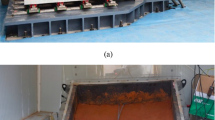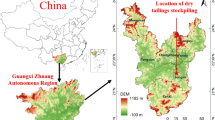Abstract
Degree of the radon and α-aerosol deviations proposed to obtain the influence of internal damage in the safety assessment of the uranium tailings dam are combined with the cloud model to establish the security and stability assessment of an uranium tailings dam, which take into account imperceptible internal damage of the dam, assisting in improving the technical evaluation. An evaluation of a large uranium tailings dam in southern China shows that the model can accurately evaluate the safety and stability of the uranium tailings dam and can provide guidance for subsequent decommissioning management.








Similar content being viewed by others
References
Carvalho FP (2007) Radioactivity in the environment around past radium and uranium mining sites of portugal. J Environ Radioactiv 96(1–3):39–46
Abdelouas A (2006) Uranium mill tailings: geochemistry, mineralogy, and environmental impact. Elements 2(6):335–341
Song S. Study on environmental risk assessment and control countermeasures of tailings pond in a mountainous area of north china. In: IOP conference series: earth and environmental science. Vol. 585(1), 2020.p. 12095.
Jiang F (2020) Comprehensive evaluation system for stability of multiple dams in a uranium tailings reservoir: based on the topsis model and bow tie model. Roy Soc Open Sci 7(4):191566
Shi J. Fuzzy-spa method based quantitative risk assessment for tailings pond. In: IOP conference series: earth and environmental science. Vol. 768(1), 2021. p. 12032.
Xun Y (2018) Comprehensive evaluation of soil near uranium tailings, Beishan city, China. B Environ Contam Tox 100(6):843–848
Igwe O (2018) Evaluation of the mechanical properties and critical slope parameters of mine tailings at Enyigba, South eastern, Nigeria. Int J Geo-Eng 9(1):1–25
Xin B. Evaluation index system and grading standard for major hazard source of tailings pond. In: IOP conference series: earth and environmental science. Vol. 252, 2019. p. 52156.
Wang G (2021) Regional hazard degree evaluation and prediction for disaster induced by discharged tailings flow from dam failure. Geotech Geol Eng 39(3):2051–2063
Zhang W (2020) Pollution and ecological risk evaluation of heavy metals in the soil and sediment around the HTM tailings pond, Northeastern China. Int J Env Res Pub He 17(19):7072
Curt C (2011) A dam assessment support system based on physical measurements, sensory evaluations and expert judgements. Measurement 44(1):192–201
Wu P (2022) Solution and stability analysis of sliding surface of tailings pond under rainstorm. Sustainability 14(5):3081
Zhu R (2017) Model averaging for multivariate multiple regression models. Statistics 52(1):205–227
Tien T (2012) A research on the grey prediction model gm (1, n). Appl Math Comput 218(9):4903–4916
Cui K (2019) Research on prediction model of geotechnical parameters based on bp neural network. Neural Comput Appl 31(12):8205–8215
Yan F (2019) Methodology and case study of quantitative preliminary hazard analysis based on cloud model. J Loss Prevent Proc 60:116–124
Eu S (2022) Influence of debris-flow impact on the structural stability of check dams. Front Earth Sci 10:887102
Ma X. Analysis on seepage flow and dam stability of ecological permeable dam In: IOP conference series: earth and environmental science. Vol. 643(1), 2021. p. 12150.
Xiao H (2019) Research on dynamic evaluation model of slope risk based on improved VW-UM. Math Probl Eng 2019:1–13
Zhang Y. Study on the reservoir dam slope stability considering the effect of seepage. In: IOP conference series: earth and environmental science. Vol. 560(1), 2020. p. 12049.
Tavana M (2021) Analytical hierarchy process: revolution and evolution. Ann Oper Res 326:879–907
Funding
This work was supported by the National Natural Science Foundation of China (Grant No. 12005099), and the Key Research Project of Hunan Provincial Education Department (Grant No. 19A425).
Author information
Authors and Affiliations
Corresponding author
Ethics declarations
Conflicts of interest
The authors declare that they have no conflict of interest.
Additional information
Publisher's Note
Springer Nature remains neutral with regard to jurisdictional claims in published maps and institutional affiliations.
Rights and permissions
Springer Nature or its licensor (e.g. a society or other partner) holds exclusive rights to this article under a publishing agreement with the author(s) or other rightsholder(s); author self-archiving of the accepted manuscript version of this article is solely governed by the terms of such publishing agreement and applicable law.
About this article
Cite this article
Chen, Z., Lan, M., Zhang, M. et al. Safety and stability evaluation of uranium tailings dam considering radioactive deviation degree. J Radioanal Nucl Chem 332, 3547–3558 (2023). https://doi.org/10.1007/s10967-023-09037-6
Received:
Accepted:
Published:
Issue Date:
DOI: https://doi.org/10.1007/s10967-023-09037-6




